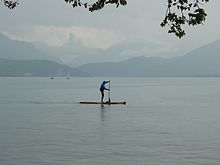スポンサーリンク
Contents
スタンドアップパドル・サーフィンガールとサーファー 福岡 糸島 大口ポイント
スタンドアップパドル・サーフィン
出典: フリー百科事典『ウィキペディア(Wikipedia)』
スタンドアップパドル・サーフィン(Stand up paddle surfing)は、ウォータースポーツの一つ。サーフボードの上に立ち、一本のパドルで左右を交互に漕ぎ、海などの水面を進む。使用するスタンド・アップ・パドルボード(Stand Up Paddleboard)の頭文字をとって「SUP」(サップ)という略称 [1]や「立ちこぎボード」という日本語の呼び方[2]もある。
歴史
サーフィン用のボードは通常、つかまって泳いだり、上に座るかうつ伏せになって波乗りのタイミングを待ったりする。SUPは1960年代、米国ハワイ州ワイキキのビーチボーイズらによって、始められた。大きなサーフボードの上でパドルを使い漕ぐ乗り方が生まれた。
近年になり、ハワイのマウイを拠点とするビッグウェイヴサーファーのレイヤードハミルトンやデイブカラマ、マカハビーチボーイズ、オアフ島のブライアン・ケアルラナや、デイブ・パーメンター等によって再び注目を浴びるようになる。 当初はトゥインサーフィンの足腰の練習用として始められたが、これによって沖からのテイクオフもパドルを使う事により可能になり、ロングボードのターンにもパドルがより有効な事が認知された。
長距離を移動する事も可能であり、波や風の無いフラットな海水面でも楽しめる事から、ハワイでは子供から高齢者まで許容範囲の広いマリンスポーツとして注目されている。不安定なボードの上に乗ってバランスを取ることにより全身運動につながり、股、太もも、首、ひざ等が鍛えられるエクササイズ効果がある事も魅力の一つとされている。
日本にも伝わり、流れが緩い河川を含めて楽しまれるようになった。釣りで1人乗りボートの代わりに使われることもある。日本シティサップ協会(大阪市) [1]や日本SUP振興会(神奈川県)といった愛好者団体も作られている。水難事故も起きており、海上保安庁は2018年、安全指針(ウォーターセーフティガイド)を策定した。事前に天候を調べ、救命胴衣を着用し、ボードと離れ離れにならないように足とリーシュコードで結びつけて水に出ることを勧めている。遭難時に通報できるよう防水袋に入れた携帯電話も持って出ることも呼び掛けている[2]。
Standup paddle boarding in Lake Annecy
Kai Lenny, World Cup Sylt 2009
Stand up paddle surfing and stand up paddle boarding (SUP) is an offshoot of surfing that originated in Hawaii. Unlike traditional surfing where the rider sits until a wave comes, stand up paddle boarders stand on their boards and use a paddle to propel themselves through the water. The sport was documented in a 2013 report that identified it as the outdoor sporting activity with the most first-time participants in the United States that year.[1] Variations include flat water paddling for outdoor recreation, fitness, or sightseeing, racing on lakes, large rivers and canals, surfing on ocean waves, paddling in river rapids (whitewater SUP), Paddle board yoga and even fishing.
Stand up paddlers wear a variety of wet suits and other clothing, depending on water and air temperature since most of their time is spent standing on the board.
A related, traditional sport, paddleboarding, is done kneeling on a board and paddling with the hands, similar to a butterfly swimming stroke. The term “kooks" is sometimes incorrectly used to refer to stand up paddle surfing.
Historian and writer Steve West claimed that the contemporary notion of stand up paddle boarding, if attributed to the Waikiki Beach Boys of Oahu during the 1960s, considers that outrigger canoeing should be recognised as the direct link between the idea of standing on a board and propelling it with a canoe paddle, since the individual SUP skills (board riding and paddling) already existed, used by people who had traditionally grown up learning them.
Standup paddleboarding (SUP), the act of propelling oneself on a floating platform with the help of a paddle or pole, traces back to thousands of years ago and across many continents, but its current form and popularity originated in Hawaii in the 1900s. Records of earlier forms of SUP have been found as early as 1,000 B.C. (i.e. 3,000 years ago) and its iterations span over various regions such as Peru, Israel, Italy, China, and beyond. By contrast, the modern form of stand up paddle boarding, where a surfboard-like vessel is used, has a much clearer heritage, dating back to the 1900s and emerging from a collection of loosely related activities by a few very specific characters, such as Duke Kahanamoku and Dave Kalama. Once it reached California in the early 2000s, stand up paddling formed four epicenters, each with its own fountainhead: Rick Thomas (San Diego), Ron House (Dana Point/San Clemente), Laird Hamilton (Malibu) and Bob Pearson (Santa Cruz). From there, the sport gained exponential popularity and California served as the catalyst for worldwide adoption. By 2005, SUP, which had till then been almost entirely a surfing discipline, began to diversify into racing, touring, rivers, yoga, and fishing. Its surfing heritage coupled with its various disciplines made the sport attractive and accessible to everyone all over the world, paving the way for its global growth and enthusiastic adoption.
By the early 2000s, Archie Kalepa and the Hobie Dream Team gave the world a hint that stand-up paddleboarding had a potential far grander than waves. Kalepa began unofficially participating in cross-channel races between the islands of Hawaii, making him one of the forefathers of downwind stand up paddle racing. Meanwhile, in California, three exceptional athletes (Chuck Patterson, Colin McPhillips, and Byron Kurt) joined forces to represent the newly formed Hobie SUP Race Team. These three would show up at local prone paddleboard races, which were just beginning to have SUP divisions, and put on a show of not only performance but also product R&D. Each would carefully pull his board in and out of board bags, trying to keep their edge in product development on the nascent race scene. Sensing and expanding on that flatwater movement, Ernie Brassard (together with Rick Thomas, Bob Pearson, Blane Chambers and a few others) organized the world’s first inland SUP event and race, hosted at King’s Beach on the north shore of Lake Tahoe, California. It was dubbed “Ta-hoe Nalu” and still runs to this day. That event back in 2007 was arguably the world’s first stand up paddle specific event. Since then, the market has evolved to include paddle boards meant specifically for flat water.
SUP originated in Africa where it was common practice for individuals to stand on their canoes and use their paddle to propel themselves forwards. This method was used by warriors in an attempt to conduct stealth attacks.[citation needed]
The contemporary form of the sport originated in the 16th century where Hawaiian surfers would surf on boards of up to 5 meters in length. These surfers used a paddle to operate boards that were otherwise unwieldy.
SUP continued in Tel Aviv in the twentieth century where lifeguards stood on wide boards to ensure a clear view of possible swimmers in distress. The lifeguards used a paddle to propel them through the water quickly to rescue swimmers.
In the 1940s Waikiki surf instructors Duke Kahanamoku and Leroy and Bobby AhChoy began SUP as a way to stand on their boards during incoming swells, known as Beach Board surfing.[2]
In the 1990s SUP was taught at Hawaiian surf schools as an alternative way to surf when there was little swell. This practice became increasingly popular so surf instructor Brian Keaulana decided to add ‘’Beach Boy Surfing’’ to the world-recognized ‘’Buffalo Big Board Contest’’ in 2003. The response to this new category was overwhelming, with many recognized surfers choosing to partake.
SUP races became common; in 2012 Kai Lenny won the season's finals of the first Standup World Series championship races.
The first magazine devoted to the sport, Standup Journal, was founded in June 2007.[3]





